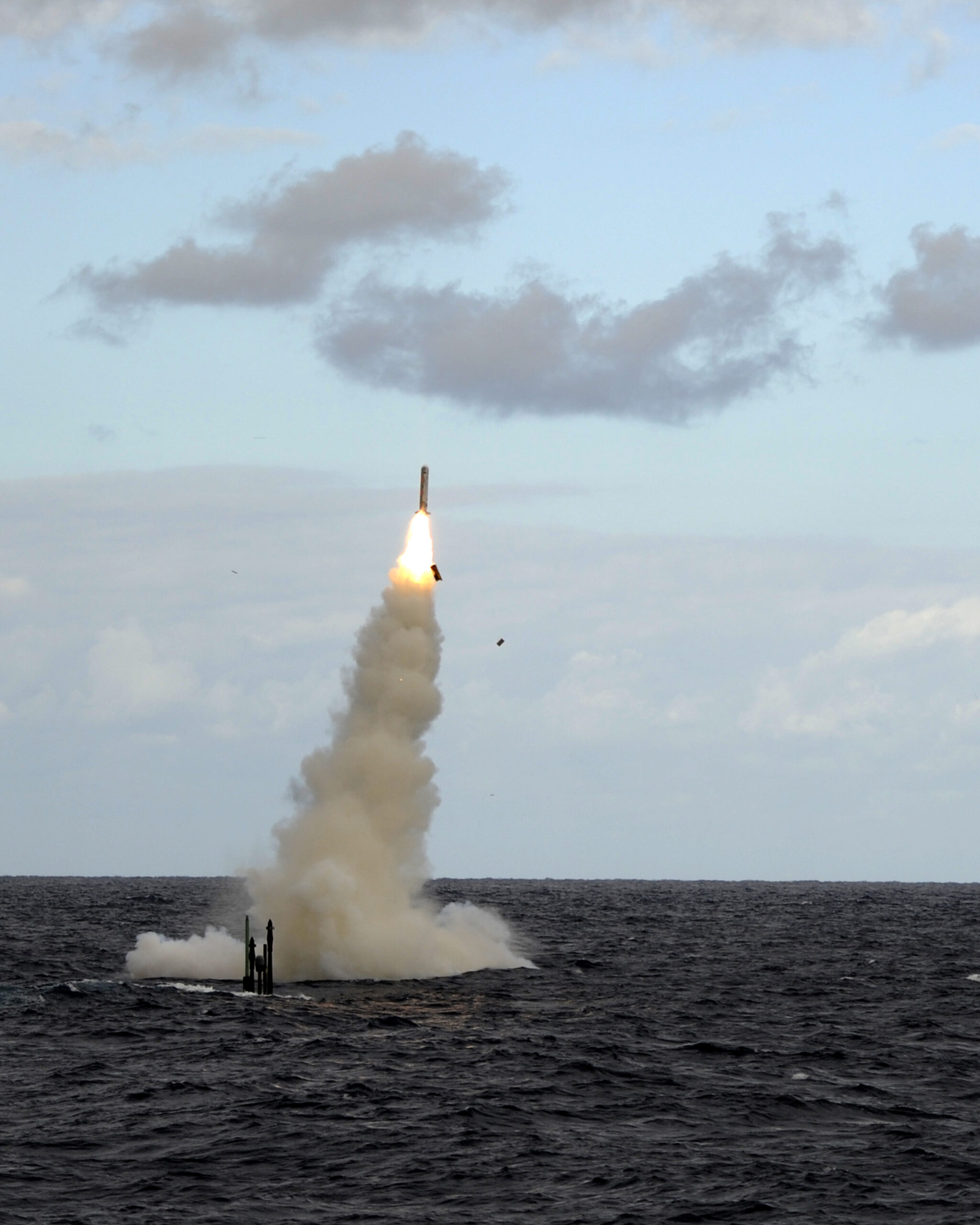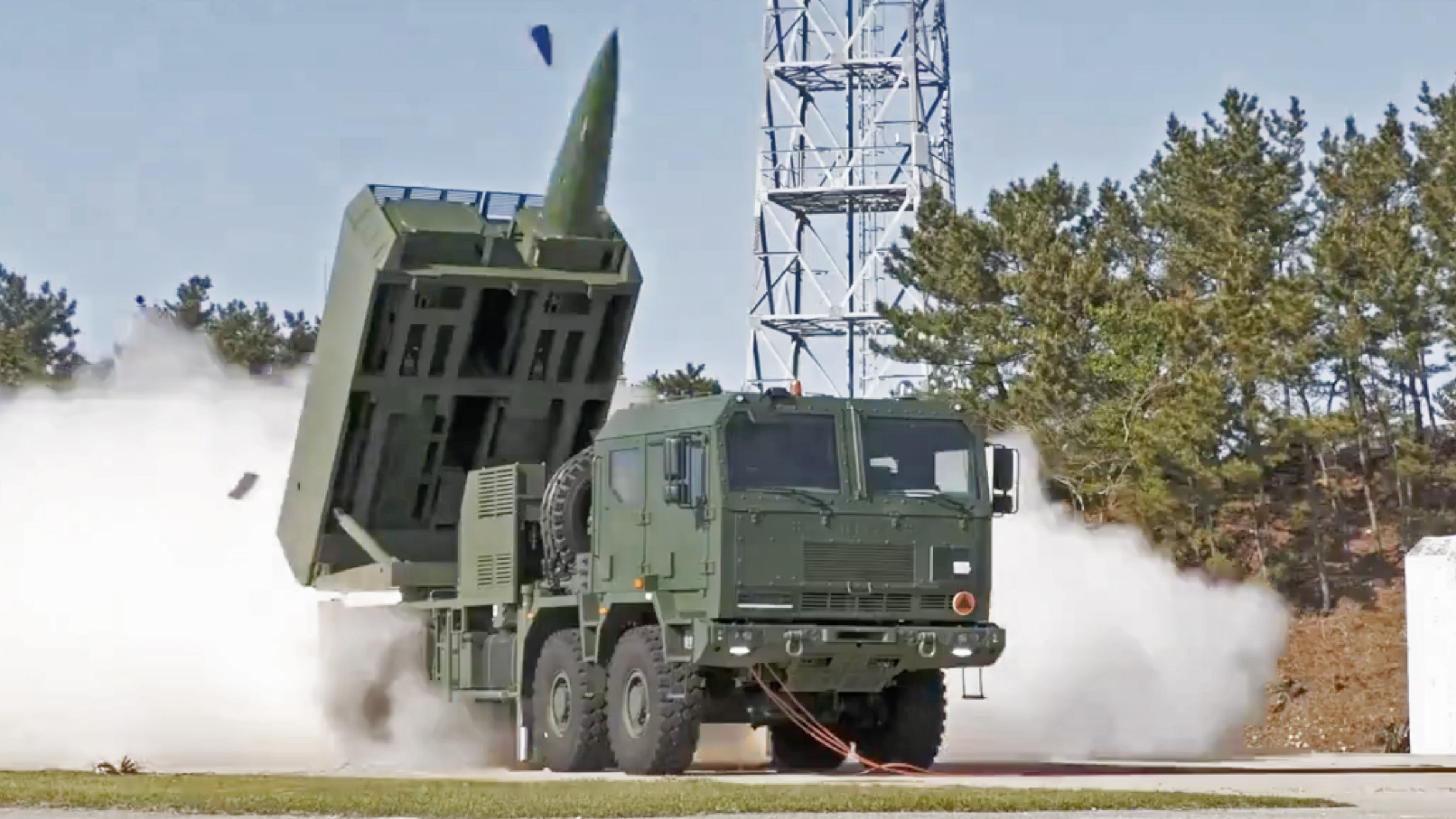A new video shows, apparently for the first time, Poland’s new short-range ballistic missile in action. The CTM-290 missile is made in South Korea and offers broadly similar capabilities to the U.S.-made MGM-140 Army Tactical Missile System (ATACMS), which has become one of the pre-eminent weapons in the war in Ukraine. The CTM-290 is launched from the Homar-K multiple launch rocket system (MLRS), based on a Polish-built truck chassis, and is indicative of a widening military relationship between Poland and South Korea. In recent years, this has also seen the Eastern European country buy light combat aircraft, tanks, and self-propelled artillery from Seoul.
The footage showing the CTM-290 missile being launched from the Homar-K was reportedly taken during a presentation for Polish government officials. This is said to have taken place yesterday at a range belonging to South Korea’s Agency for Defense Development (ADD) located in Anheung, around 60 miles southwest of Seoul.
The missile’s outward similarity to the ATACMS is obvious, down to the single-round missile pod that slots into the wheeled MLRS launcher vehicle, which can also fire a range of other projectiles. The CTM-290 shares very similar dimensions with the ATACMS, including a diameter of 600 milimeters for the South Korean missile, compared to 610 milimeters for the MGM-140, although the weapons are not compatible with each other’s respective launchers.
The type of warhead, or warheads supplied to Poland for its CTM-290 missiles is unclear, although South Korea is known to use a penetrator type for its equivalent KTSSM-I, to defeat hardened bunkers and other buried structures, a target set that is less relevant for the intended Polish missions.

Today, the manufacturer of the system, Hanwha Aerospace, confirmed that it had signed a $1.64-billion deal with Poland to supply it with 72 Homar-K MLRS units, part of a wider agreement dating from October 2022 that is worth around $22 billion, and which includes 288 examples of the MLRS, plus various other weapons.
Hanwha Aerospace said that the latest deal would take effect only after a separate financial contract, with government support, is signed by the end of November, Reuters reports. An initial batch of 18 of the MLRS plus ammunition were reportedly delivered to the Polish Armed Forces last year.

The Homar-K MLRS is the Polish version of the South Korean K239 Chunmoo. In its Polish configuration, the MLRS is integrated with a Polish-made Jelcz 8×8 truck chassis. The Homar-K also has various other Polish components and subsystems, including fire control, communication, and battlefield management systems, with local defense industry playing a major role in the overall integration effort.
In both the original Chunmoo and the Homar-K, the launch vehicle carries two missile containers. In the Polish version, these can contain a single CTM-290, as demonstrated at Anheung, with a range of approximately 290 kilometers (180 miles), or six 239mm CGR-080 precision-guided artillery rockets with a range of approximately 80 kilometers (50 miles), according to the manufacturer. Examples of the CGR-080 rocket are seen being launched in the video below.

The stated range of the CTM-290 puts it in the same category as the longest-range versions of ATACMS, which can find their mark out to 300 kilometers (186 miles), compared with 140 kilometers (87 miles) for the shortest-range ATACMS variants. In the case of Ukraine, only the shorter-range missiles were provided at first, although the United States yesterday committed also to the supply of longer-range variants to Ukraine “as soon as practicable” — additional reporting from multiple outlets suggests that those munitions have already been secretly sent to Ukraine.

For its part, the CGR-080 is broadly equivalent to the M30A1 and M31A1 227mm precision-guided rockets fired by the U.S.-made M142 High Mobility Artillery Rocket System (HIMARS). Both these types have a stated maximum range of at least 70 kilometers (43 miles) and have been used to considerable effect in the war in Ukraine.
“Chunmoo is a key asset of South Korea’s self-reliant defense capability, and the advanced artillery system will be taking the roles of defending the Polish border, and the Polish Chunmoo MRLS will be supplied as fast as possible to contribute to the military buildup of Poland,” Son Jaeil, the President and CEO of Hanwha Defense said back in October 2022, when the original contract agreement was announced.

It’s notable that a lot of the requirements for the defense of Poland align with those of South Korea.
Both countries share a border with an unpredictable neighbor that has a vastly numerically superior military, especially in terms of mechanized infantry and armored formations.
South Korea originally developed the Chunmoo as part of its ‘kill chain’ concept, in which the MLRS would contribute to efforts to blunt any land invasion by the North, including SRBMs to strike areas in the enemy’s rear.
With broadly similar concerns about a potential Russian thrust across its border, or elsewhere in the region, Poland looked to South Korea as it set about modernizing and expanding its armed forces after Moscow launched its full-scale invasion of Ukraine in February 2022.
While Poland requested almost 500 examples of the U.S.-supplied HIMARS, it was unhappy about the long delivery time and instead looked to South Korea for an alternative in the shape of the Chunmoo.
“We’re aware that we will not receive all 500 HIMARS launchers, for which we have sent a letter of request, within a timeline that would be satisfactory to us,” Polish Deputy Prime Minister and Minister of Defense Mariusz Błaszczak said at the time. “We decided to split the HIMARS order into stages. We will have both the HIMARS and the Chunmoo.”
In the meantime, the first examples of the HIMARS were also delivered to Poland in 2023.

With its ability to hit targets at almost 300 kilometers, the CTM-290 is a particularly notable addition to the Polish Land Forces and is part of a growing focus the country is placing on its long-range strike capabilities.
These capabilities received another major boost with the announcement last month that the U.S. Department of State had approved a possible sale to Poland of up to 821 examples of the Joint Air-to-Surface Standoff Missile-Extended Range (JASSM-ER), worth $1.77 billion.

This follows on from a Polish previous order for 70 JASSM-ER weapons in 2016, to arm its F-16C/D Block 52+ fighters. Since then, Poland has also committed to buying 32 F-35A stealth fighters which will also be armed with JASSM-ER, albeit carried externally. Furthermore, Poland has been suggested as a possible future customer for the F-15EX fighter, which would likely be prioritized for standoff strikes against surface targets, as we have discussed previously.
Only this week it was announced that Poland had received approval for a purchase of up to 360 examples of the AGM-88G Advanced Anti-Radiation Guided Missile – Extended Range (AARGM-ER). Allied with the F-35, these will provide a very significant boost to Poland’s ability to attack hostile air defenses at standoff range.
Beyond this, Poland has expressed interest in buying Tomahawk land attack cruise missiles for its planned new fleet of conventionally powered submarines, which are being procured under the Orka program. At the same time, the Polish Navy is planning to acquire new surface combatants that will be equipped with the Mk 41 vertical launch system that’s also compatible with the Tomahawk.

However, expanding the long-range conventional strike capabilities of the Polish Navy is very much a long-term project, meaning that the CTM-290 and the JASSM-ER are also being acquired as very important gap-fillers.
Such projects — and others, including advanced new U.S.-supplied tanks and attack helicopters — have been aided by a significant hike in defense spending. Poland now invests 4.23 percent of its GDP in its armed forces, more than double the NATO target of 2 percent.
While Russian aggression against Ukraine provides a reminder to Poland of the importance of robust defenses, there are already some questions being raised about how sustainable this spending is. In particular, there have been concerns over the financial terms of Poland’s purchases of South Korean arms.

There is also the fact that South Korean equipment generally doesn’t conform to NATO standards, making its integration with Western systems harder. In the case of the Homar-K especially, Poland seems to have decided it was more important to get its hands on these weapons faster, and in greater numbers, for which South Korea’s impressive industrial capacity was determined to be the answer.
For now, at least, sales of equipment such as the Homar-K MLRS ensure that Poland is South Korea’s most important military export customer. The acquisition of these weapons represents an important factor in Poland’s expanding long-range strike capability.
Contact the author: thomas@thewarzone.com
